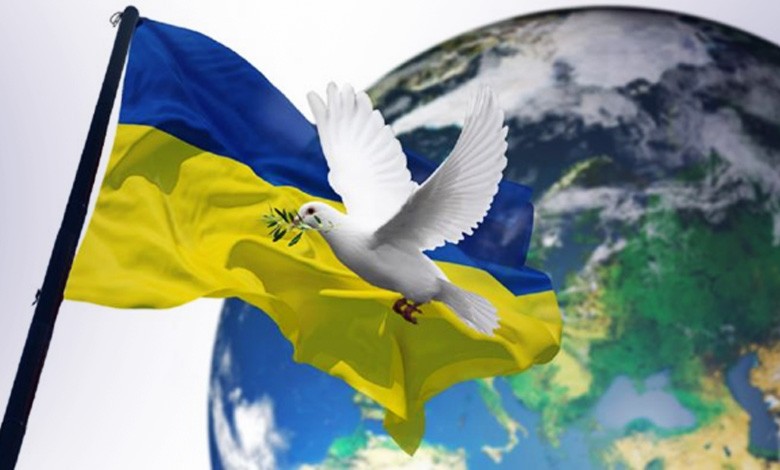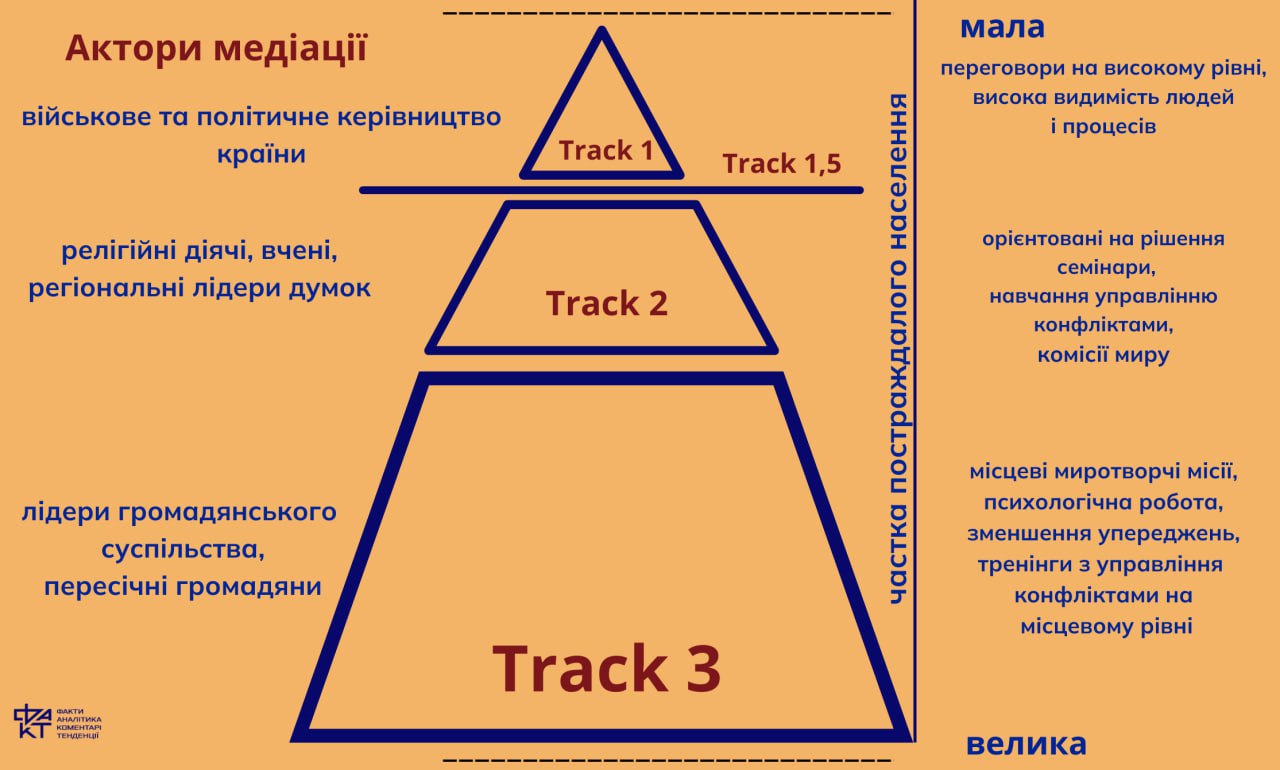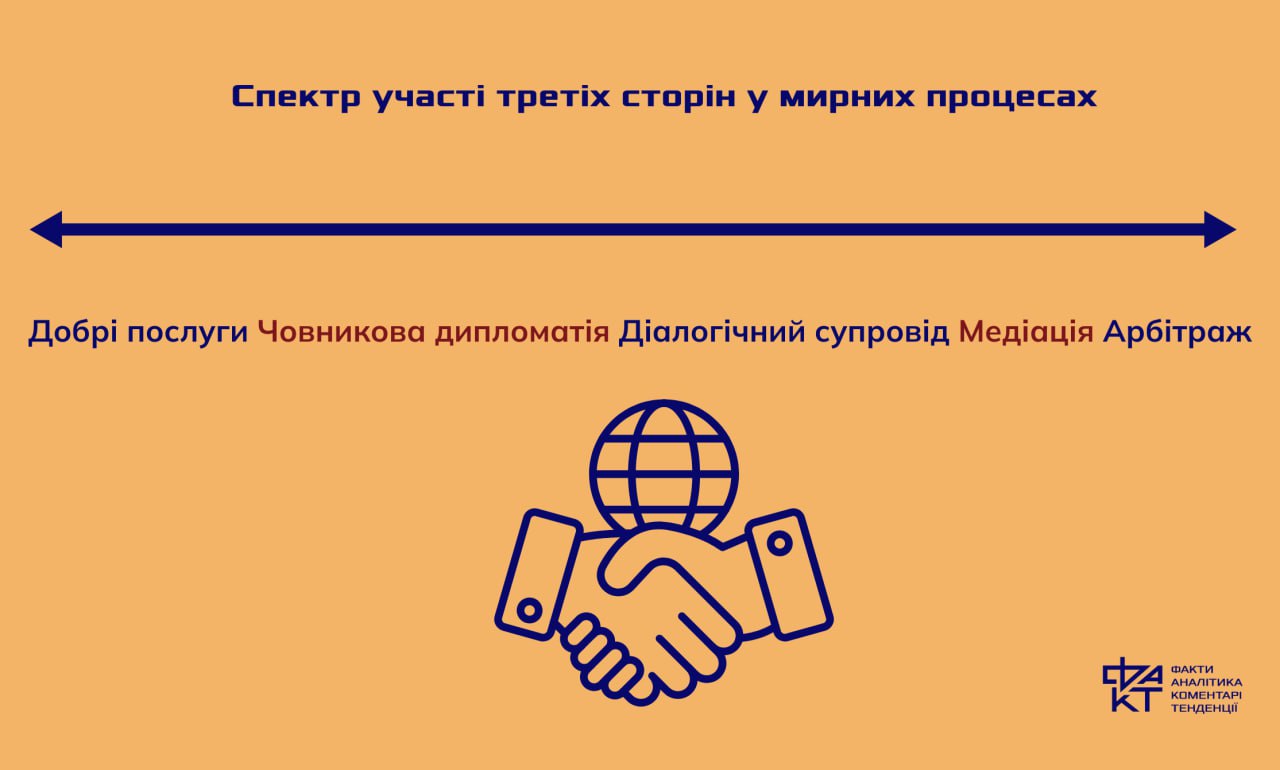Peacemaking in Action: How Mediation is Helping Ukraine Find a Path to Sustainable Peace

Today, when talking about the war in Ukraine, the world is increasingly looking for appropriate diplomatic approaches that would ensure sustainable peace in our country. In modern diplomacy, there was even a separate term “mediation in peacekeeping” – a general concept that covers various tools for solving internal and interstate conflicts. These include mediation as such, approaches to support mediation, and dialogic processes related to mediation. Mediation efforts are usually carried out by external actors with appropriate mandates and mediation tools. A key role in this is played by states, which can make a significant contribution to achieving peace both in formal and informal, non-public settings. At the same time, in successful mediation cases, in addition to states, dialogue with the parties to the conflict is also conducted by non-institutionalized actors who have sufficient authority, expert knowledge and a high level of trust of both parties.
Support of peace processes by third parties
Peace processes can take place at different social levels and be supported by external actors — third parties. There are four levels:
First level (Track 1) covers the political and/or military leadership of a particular country. The level involves negotiations at the highest level. The processes and persons of the mediators are transparent to the general public.
Second level (Track 2) includes leaders of society, such as religious figures, intellectuals or regional power figures – powerful people who have a high status in a certain reference group or local community. At this level, various measures (seminars, peace commissions) are used to promote understanding between the participants in the conflict.
Third level (Track 3) concerns representatives of civil society.
How can we not mention Paul Lazarsfeld’s two-stage model of communication, according to which the majority of people receive information not directly from the source, but through opinion leaders. They select content, interpret it, evaluate it and pass it on to the general public. This is where the theory of critical mass, borrowed from nuclear physics, comes into play, where it indicates the amount of matter needed to sustain a chain reaction. In a similar way to society, this concept reflects the minimum number of people or support necessary for a certain idea, movement or change to begin to actively develop and have a real impact. This is approximately 10-20% of the population. When this critical mass is reached, changes can spread more quickly and become autonomous decisions, involving more people and stimulating new initiatives. Even a peacemaking initiative must be promoted in society, properly interpreted, so that certain sections of society do not resist. Society is diverse, therefore, at the third level, it is necessary to work with negative stereotypes, superstitions, cautions caused by different identification orientations of people.
It is significant that the share of the affected population affects the coverage of actors involved in mediation. When a conflict affects the entire population, the participation of ordinary citizens in mediation processes can be a decisive factor in achieving sustainable peace. Citizens can express their fears, hopes and demands, which will help form a more complete picture of the conflict and find ways to understanding. For successful mediation, it is important to take into account not only political and military aspects, but also socio-cultural, economic and environmental ones. It is also necessary not only to involve people in mediation processes, but also to provide them with relevant knowledge and skills. Conducting trainings and workshops for citizens who wish to participate in mediation can significantly increase the effectiveness of their participation.

In practice, it turned out that it is expedient to supplement this three-level scheme with one more component – the Track 1.5 level. At it, influential representatives of political and social institutions meet in an informal setting. As a rule, this is an interaction aimed at preparing and evaluating opportunities for negotiations at the Track 1 level. At the same time, mediation in peacemaking reveals its full potential only under the condition of coordinated interaction between all levels. Therefore, a multi-level approach is necessary for a sustainable peace process.
In general, the work of third parties in conflict situations can take different forms at different levels, starting with Good Offices (providing a place for negotiations), Shuttle-Diplomacy (shuttle diplomacy), dialogue support and mediation, up to arbitration.

An example of Good Offices can be the role of the UN in the Cyprus conflict.
Here, the UN acted as a mediator, providing a venue for negotiations between Greek and Turkish Cypriots. Mutual resettlement of Greek Cypriots and Turkish Cypriots was carried out under the supervision of UN peacekeepers. The parties to the conflict were divided by the so-called “green line” — the UN buffer zone. The country was permeated by a border that created a physical and social barrier between the Greek and Turkish communities.
An example of classic shuttle diplomacy is provided by Turkish President Erdogan, who seeks to act as a mediator between Ukraine and Russia in order to persuade us to resume the peace process. Polytechnic experts believe that Turkey’s global goal is to show that it is the only indispensable mediator and, accordingly, the key state in the region and to lock in important topics that will automatically become part of any post-war peace agreements between Ukraine and Russia.
Supporting the dialogue – here we can mention the role of Switzerland in the process regarding Syria. In the Swiss city of Geneva, negotiations between the Syrian government and opposition groups were held repeatedly with the participation of international mediators. Switzerland provided a platform for dialogue, facilitated the process, maintaining a neutral space for the exchange of views.
According to UN principles, mediation is a voluntary process in which a third party helps conflicting parties to prevent, resolve or manage conflict by facilitating mutually acceptable agreements. Peace mediation covers all stages of negotiations, starting from the first contacts between mediators and parties to the conflict and reaching ceasefire agreements, up to the implementation of these agreements. Mediation is an important tool for both conflict prevention and peacebuilding, especially when implementing peace agreements.
To clearly understand what mediation is, it is worth comparing it with other processes such as negotiation and arbitration. Mediation, like negotiations, aims to reach an agreement between the parties. However, mediation involves a third party who is responsible for managing and maintaining the communication process. Unlike arbitration, the third party does not offer its own solution, but rather supports the parties in finding an autonomous solution, thus specifically recognizing the sovereignty and expertise of the parties to the conflict.
As an example, it is worth mentioning the arbitration court regarding the border dispute between Slovenia and Croatia. These two countries of the Balkan region had territorial disputes after the breakup of Yugoslavia. In 2009, they agreed to submit their claims to an international arbitration court. In 2017, a decision was made that partially resolved this conflict.
Mediation is similar to diplomacy in that both approaches are aimed at peaceful conflict resolution. An important common feature is the non-violent nature of both processes. However, the key difference is that diplomacy serves to achieve a country’s foreign policy goals, while mediation aims to find a common solution that satisfies all parties to the conflict. Because of this, the roles of diplomats and mediators differ, as do their working methods.
Also, diplomats often have limitations in working with certain parties to the conflict, in particular with non-state actors. Mediators, under appropriate conditions, can involve such parties in negotiations. The interaction of diplomacy and mediation can significantly increase the effectiveness of peacemaking processes and help resolve conflicts more quickly.
In particular, Norway acted as a mediator during secret negotiations between representatives of Israel and the Palestine Liberation Organization, which ended with the signing of the Oslo Accords. This process was an example of a successful mediation that resulted in important agreements for further negotiations.
A successful example of the use of an expert team is the mediation of the team led by Kofi Annan in Kenya in the spring of 2008. The former UN Secretary General was invited to mediate in the conflict between the two main political camps that erupted after the 2007 presidential election. The riots resulted in mass evictions and at least 1,500 deaths.
To defuse the conflict, the Kenya National Dialogue and Reconciliation Team, which included the Group of Eminent Africans, sought to achieve governmental cooperation and power-sharing between the two sides in the conflict. In search of expertise in the field of governmental cooperation between different political factions, Germany was invited to share the experience of building a grand coalition. The only representative of a non-African country at the negotiations was the then Minister of State in the Ministry of Foreign Affairs, Dr. Gernot Ehrler.
After months of negotiations, the first Grand Coalition in Africa was sworn in on April 14, 2008. This contributed to both short-term and medium-term stabilization of the situation. The reformed constitution adopted in 2010 became the basis for peaceful elections in 2013.
The case of Kenya shows that mediation teams—both professional mediators and prominent individuals—can significantly influence the success of peace initiatives. In addition, Germany’s specialized expertise contributed significantly to finding solutions and resolving the conflict.
Approaches to mediation
Both in theory and in practice, there are different views on what goals the mediation process should pursue, what techniques are most appropriate, and what role the mediator plays. Four main approaches can be distinguished: transformative mediation, facilitative mediation, formative mediation and power-based mediation.
Transformational approach considers mediation as a long-term process that is controlled and managed by the parties to the conflict themselves. The main focus is on changing the relationship between the parties, recognizing their different interests and needs, as well as changing the perception of oneself and opponents.
Facilitative mediation focuses on building trust between parties and identifying core interests without providing specific recommendations or solutions.
Formative mediation involves the mediator structuring the process, gathering suggestions for solutions, and offering different options. The main goal here is to find creative ways to resolve the conflict.
Power-based mediation, aimed at reaching an agreement with the help of a strong mediator who uses his power and strategic, sometimes even manipulative, methods. For example, the “whip and gingerbread” method is used, where the parties are promised rewards or threatened with sanctions to encourage them to reach an agreement.
In practice, these approaches are often intertwined, and mediators may use different approaches at different stages of the mediation process. Despite conceptual differences, all four approaches view mediation as a voluntary process in which all parties participate on equal terms and the mediator acts as a neutral mediator. The main principles of mediation are voluntariness, equal participation and impartiality.
In the context of Russia’s full-scale war against Ukraine, mediation has significant potential not only as a tool to end hostilities, but also as a means of preparing society for peaceful coexistence after the end of the war. Critically, mediation not only helps to reach agreements at the political level, but also helps to overcome social trauma and reduce polarization in society.
In Ukraine, where the war affects the entire population, the role of civil society and informal mediators (Track 3) becomes crucial. This creates a new understanding of mediation as a process that operates not only in a narrow circle of political elites, but also has a mass impact, contributing to the stability and reconstruction of the country after the war.





